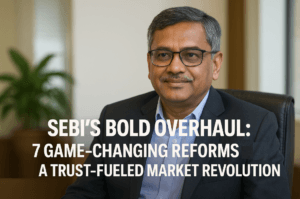Sebi’s Bold Overhaul: 7 Game-Changing Reforms Driving a Trust-Fueled Market Revolution
Under Chairman Tuhin Kanta Pandey, SEBI is prioritizing trust, transparency, technology, and teamwork to uphold its triple mandate of investor protection, market development, and regulation. By adopting risk-based regulations, the regulator aims to simplify compliance, eliminate outdated rules, and foster ease of doing business without compromising market integrity. Enhanced surveillance and a crackdown on misleading fin-fluencers (70,000+ accounts removed) underscore efforts to combat misinformation and cyber frauds.
Technological advancements like AI-driven tools and T+1 settlements are streamlining operations, while plans for energy futures signal market diversification. Collaboration with RBI and the Ministry of Corporate Affairs seeks to resolve issues like IEPF claims and implement a unified KYC framework. Amid global volatility, India’s robust payment systems, strong GDP growth, and thriving IPO market position it as a stable haven.
Pandey’s focus on investor education, ethical practices, and adaptive governance aims to empower retail participants, ensuring India’s capital markets remain secure, innovative, and globally competitive.

Sebi’s Bold Overhaul: 7 Game-Changing Reforms Driving a Trust-Fueled Market Revolution
In a rapidly evolving global financial landscape, Tuhin Kanta Pandey, the newly appointed chairman of the Securities and Exchange Board of India (Sebi), has outlined a transformative roadmap to strengthen India’s capital markets. With a focus on the regulator’s triple mandate—investment protection, market development, and regulation—Pandey’s strategy revolves around four pillars: trust, transparency, technology, and teamwork. Here’s how these elements are shaping Sebi’s vision for a secure, innovative, and inclusive market ecosystem.
Trust: The Bedrock of Market Integrity
Pandey emphasizes that trust is a two-way street: investors must have faith in Sebi, and the regulator must trust its stakeholders. To achieve this, Sebi is revisiting conflict-of-interest norms and adopting risk-based regulations.
- Regulatory Optimization: Outdated rules are under scrutiny. For instance, micromanagement in low-risk areas may be eliminated, while high-risk segments (like volatile SME IPOs) face stricter oversight. This balance aims to reduce compliance burdens without compromising investor safety.
- Ease of Doing Business: By simplifying regulations, Sebi seeks to foster innovation while maintaining market integrity. Pandey notes, “Our regulations must evolve with technological advancements and shifting market dynamics.”
Transparency: Strengthening Accountability
Transparency is critical to curbing misinformation and ensuring fair play. Key initiatives include:
- Common KYC Framework: Collaborating with the RBI to streamline Know-Your-Customer processes across financial sectors, reducing redundancy for investors.
- Combating Cyber Frauds: Over 70,000 misleading “fin-fluencer” accounts have been removed from platforms like YouTube, with stricter oversight on unauthorized investment advice.
- Social Media Engagement: Sebi is enhancing its digital presence to counter misinformation and provide real-time updates, ensuring stakeholders access accurate information.
Technology: Powering Progress and Risk Management
Technology is a double-edged sword, offering efficiency but also risks. Sebi’s approach includes:
- AI Integration: Leveraging artificial intelligence for surveillance, fraud detection, and regulatory processes. However, Pandey cautions, “*AI’s risks demand robust mitigation strategies, especially in algorithmic trading and data security.*”
- Settlement Innovations: The shift to T+1 settlement (transactions settled in one day) has improved liquidity, though Pandey believes current systems are sufficient, signaling cautious adoption of newer frameworks like T+0.
- Energy Futures: Plans to expand derivatives markets, including energy futures, highlight efforts to diversify investment avenues while addressing regulatory hurdles.
Teamwork: Collaborative Governance
Pandey stresses collaboration across stakeholders:
- Inter-Regulator Coordination: Partnering with the Ministry of Corporate Affairs to resolve Investor Education and Protection Fund (IEPF) claims faster. “Proactive resolution,” he notes, “can prevent unclaimed funds from reaching IEPF in the first place.”
- Global Investor Outreach: Engaging foreign institutional investors (FIIs) and easing entry barriers for overseas retail investors (pending FEMA reforms) to deepen market participation.
Navigating Global Volatility: India’s Resilience
Amid geopolitical tensions and economic headwinds, Pandey reassures investors of India’s stability:
- Robust Infrastructure: Sebi’s 24/7 surveillance and fail-safe settlement systems ensure market continuity even during sharp downturns.
- Strong Fundamentals: With 6.5% GDP growth, supportive fiscal policies, and a thriving IPO market (India led globally in 2023 listings), the economy offers relative safety compared to struggling emerging markets.
Investor-Centric Reforms Ahead
- Direct Foreign Access: Discussions to allow foreign individuals to invest directly (beyond FII channels) could democratize access, pending KYC and risk assessments.
- Education Over Restriction: Enhancing financial literacy to deter risky behaviors (e.g., borrowing to invest) through partnerships with mutual funds and regulators.
- Reverse Flip Boost: Encouraging overseas-listed Indian firms to “flip” back to domestic exchanges, leveraging India’s growth narrative.
The Road Ahead: Balancing Innovation and Caution
Pandey’s leadership marks a shift toward adaptive regulation—embracing tech advancements while prioritizing investor welfare. By fostering trust through transparency, modernizing infrastructure, and strengthening collaborations, Sebi aims to position India as a global market powerhouse resilient to external shocks.
As Pandey aptly summarizes, “Markets thrive when participants feel secure. Our job is to ensure that integrity and innovation go hand in hand.” For millions of new retail investors, this ethos could redefine India’s financial future.
Engage, Educate, Empower—Sebi’s renewed focus on these principles underscores its commitment to a market ecosystem that’s not only robust but also inclusive, ready to harness opportunities in an uncertain world.
You must be logged in to post a comment.